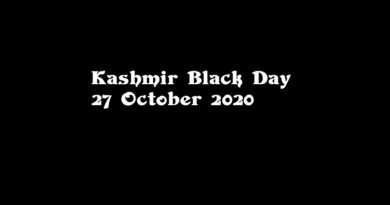Shawl weavers’ sacrifice
While the world commemorates the sacrifice of a few Chicago labourers on May 3, nobody makes even a mention of the sacrifices offered by Kashmiri shawl weavers on April 29, 1865 at Zaldagar.
On May 3, people across the globe commemorate the sacrifices offered by labourers at Chicago. On May 3, 1886 labourers took out a procession to press their demands. One labourer was killed when police opened fire at the demonstrators. On the following day (May 4) a protest demonstration was staged at Hay Market Square by the labourers. A bomb was hurled at the police men. Seven of them died on the spot and around 70 sustained injuries. In retaliatory action a few labourers also got killed. Since then May 3 is observed every year across the globe.
While the world commemorates the sacrifices of Chicago workers, nobody makes a mention of the Kashmiri shawl weavers who resisted the Dogra onslaught tooth and nail. On July 6, 1847 around four thousand shawl weavers observed strike against exploitation by the Dogra rulers. This is the first strike observed by workmen anywhere in the world. Soon after, thousands of weavers migrated to Lahore via Shopian. A British officer, Lt Reynell Taylor rushed to Shopian and persuaded the weavers to refrain from migrating to Lahore. Some grievances were taken note of.
In 1856 Ranbir Singh ascended the throne. Gulab Singh suffered an attack of Dropsy which ultimately killed him in 1859. Ranbir Singh strictly followed his father and imposed severe tax on the shawl weavers. Raw material, import of wool from Ladakah was also taxed. Besides custom duty, tax was also imposed on the finished products. According to some historians around 300% tax was imposed on the shawls which broke the back of shawl industry. At that time around 125 thousand were involved in the shawl industry. These included weavers, washermen, skilled labourers having know how of printing. The industry generated more than Rs 50 lakh annually. In 1865 shawls worth 254 thousand British Pounds were exported from Kashmir. However, the weavers got peanuts. Most of them made around Rs 5 to 7 every month that too after working 16-18 hours a day. They had to pay tax to the tune of Rs 5 monthly. They could not change their profession or stop working. Heavy fine was imposed on the weavers who had unsuccessfully migrated to Lahore. Some of them were jailed. It is worth mentioning here that Afghan governor, Haji Karimdad Khan had imposed the tax and it was then called Dag Shawl.
Meanwhile a Pundit, Raj Kak Dhar got the contract of the shawl department for Rs 12 lakh. He set up his office at Saraf Kadal (Zaina Kadal) and imposed tax to the tune of Rs 49 on the shawl weavers. Dhar was patronized by the government and would take army along to recover tax. The weavers approached the then governor Kripa Ram to apprise him of their woes but he did not listen to them. To press their demands the weavers took out a procession on April 29, 1865. The processionists staged a demonstration in a ground near Zal Dagar and later decided to march towards the residence of governor. Meanwhile, Raj Dhar managed to instigate the governor who sent Col Beach Singh to take care of the protestors. The army herded the protesters towards Haji Rather Sum (A small bridge on Kut-e- Kul.) The bridge collapsed. Around 28 people drowned. Many sustained injuries. According to Dr Altaf Husain the author of Wounded Paradise, the Dogra Soldiers also opened fire on the protesters. Notwithstanding brutal repression, the people fished out all the bodies from the river and planned to take the bodies to Ranbir Singh’s palace next morning. However, they could not march towards the palace as the army intercepted them. The leaders were taken into custody. Sheikh Rasool and Abli Baba were tortured to death in a dungeon in Shergarhi palace. Some of them were severely fined.
On May 1 some prisoners including Ali Paul, Rasool Sheikh, Quda Lala and Sona Shah were sent to Jammu. Ali Paul and Rasool Sheikh died of tuberculosis in Ram Nagar Jail. Quda Lala and Sona Shah met the same fate. Nobody knows how the first martyrs of Trade Union Movement were treated. No charge sheet was produced in any court. No enquiry was constituted. The inaction of the government only encouraged the army and the bureaucracy. Kashmiris continued to suffer.
The local trade union leaders cannot escape responsibility of not setting the historical records right. Most of them do not even know that a major incident took place at Zaldagar on April 29, 1865. They take out processions and hold debates and seminars on May 3 but have miserably failed to tell the world how, when and where the first organized strike of the workers was observed.
They can rectify the wrong by taking measures now. A memorial must come up at the site of the massacre at Zaldagar. This is the least they can do. Let them start the noble job this year by holding a seminar on the Zaldagar martyrs.
The great martyrs have been ignored by the government as well. Surprisingly government assigns more importance to the struggle against Dogras from 1931. This is the time when Sheikh Muhammad Abdullah appeared on the political firmament of Kashmir. The struggle of the shawl weavers and great trade unionist G N Gilkar finds no mention anywhere.
The day (April 29) is also important for the human rights defenders. This is the day when the phenomenon of extra-judicial executions started in Kashmir. Can they ignore it?
About Author:
Zahir-ud-Din is a senior journalist based in Srinagar, capital city of Occupied Jammu & Kashmir
Courtesy:
http://risingkashmir.com/?option=com_content&task=view&id=22908

